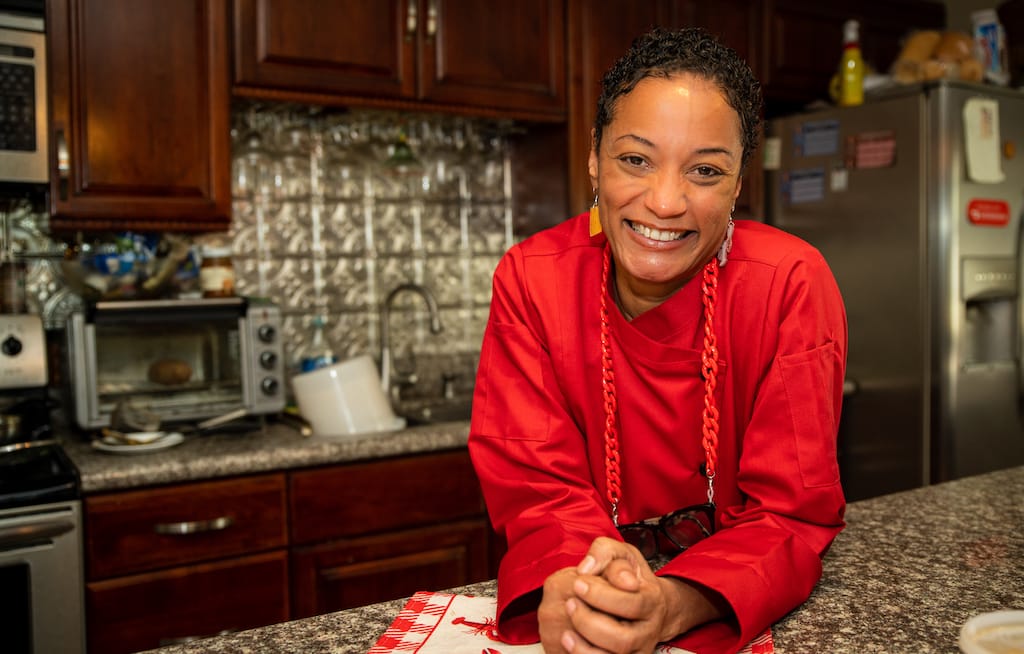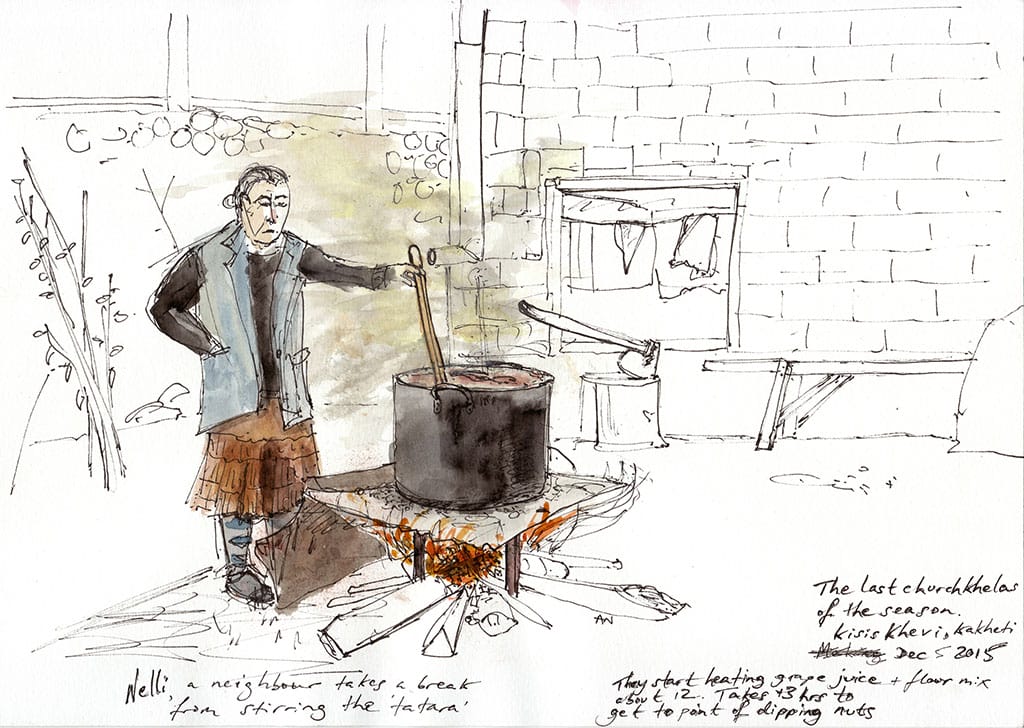Bunny Young, clad in a bright red chef’s coat and matching hat, stands in the galley kitchen of her New Orleans East home slowly stirring a pot of butter beans. She has done this thousands of times, but each time is a prayer offered to her ancestors, the generations of New Orleans 7th Ward Creole women who guided Young in the kitchen. Young is not for the faint of heart. Her bold flavors, bold personality and bold sartorial choices are reminiscent of Leah Chase, another legendary Creole chef. Young has a lot on her mind at all times, and she isn’t afraid to tell you, either. But these days, she lets her food do most of the talking, and it, too, has a lot to say. Her catering and delivery business, Crawbabies LLC, is bringing her brand of modern Creole soul food to eager customers across New Orleans – a city whose celebrated native cuisine is becoming increasingly harder to find.
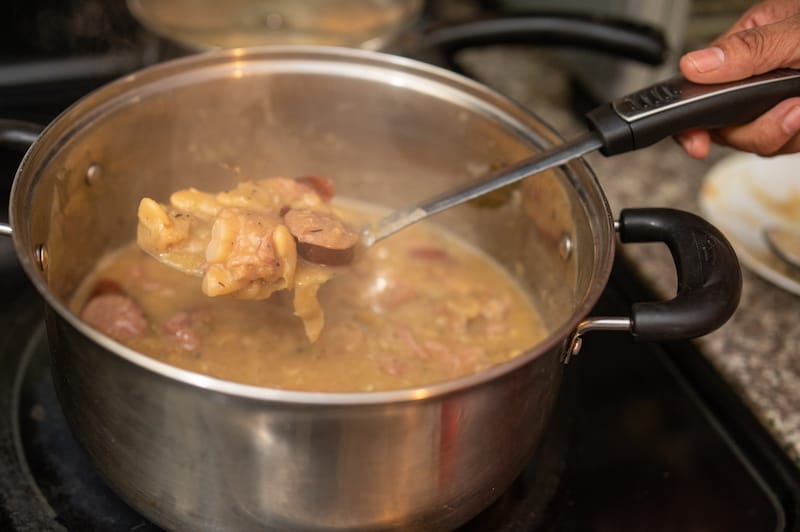
“Butter beans and rice,” said Young, when we inquired about today’s offering. “Those are the large Limas which everybody prefers cooked with smoked sausage and pork pickle tips, and cornbread and Patton’s hot sausage fried on the side. So a typical New Orleans Monday meal, sometimes red, but today I felt like white, so.”
She placed a heaping plate before us and eyed our first bite carefully. It was eye-closeing good, the kind of food that transports you to your grandmother’s kitchen, even if your grandmother was not a Creole from New Orleans’s 7th ward. The beans were cooked down into their own gravy, with just the right amount of bite, and the sausage added a pleasantly, salty, smoky counterpoint. The gravy was dutifully sopped up by the rice and the accompanying cornbread. And the Patton’s hot sausage patty was a decadent add-on, a little lagniappe, if you will.
“I put them in the pot and I boil them using one stick of butter like my grandmother taught me,” said Young, discussing her deceptively simple process. “And seasonings. Garlic, bell pepper, green onion and thyme – thyme is essential to most things that Creole people cook. So, fresh thyme, bay leaf, and I let them all cook. I let them boil first and bust – like they say, ‘let the beans bust’ – and then they bust and cook down and then you add the meat in and cover them, lower the fire and slowly let them go. Aren’t they creamy?”
She smiled, as she already knew the answer. They were perfect.
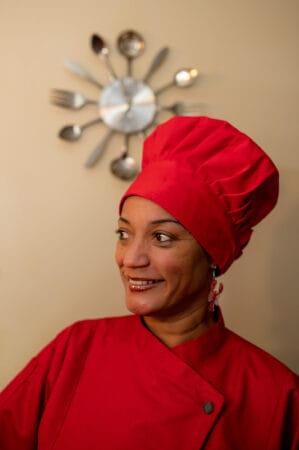
That Young’s cooking evokes memories of grandma’s cooking is no accident. “I’ve been cooking all my life – of course I have – I’m Creole,” said Young “I grew up in the kitchen with my grandmother in the 7th Ward of New Orleans.”
Her grandmother, Viola, wanted Young to learn how to cook as a life skill.
“You should always be able to feed yourself or feed your family,” said Young of her introduction to the kitchen. “So that was the basis of it. But I started out ancillary, doing all the grunt work, cleaning chicken, shucking corn, picking greens, all of that good stuff. And I hated it!”
Over time, though, that hatred turned to love, especially under the tutelage of her Aunt Roena, who taught Young precision, discipline and tradition in the kitchen.
“My Aunt was amazing. The best ever. Ever,” said Young with emphasis. “And I guess that’s where I get the technique from – from her.”
This technique includes trimming crawfish heads with manicure scissors to remove the whiskers for use in the traditional Easter crawfish bisque. The dish is so labor intensive that Young only makes it once a year. It is a tribute to her aunt, who instilled much more than culinary training in Young.
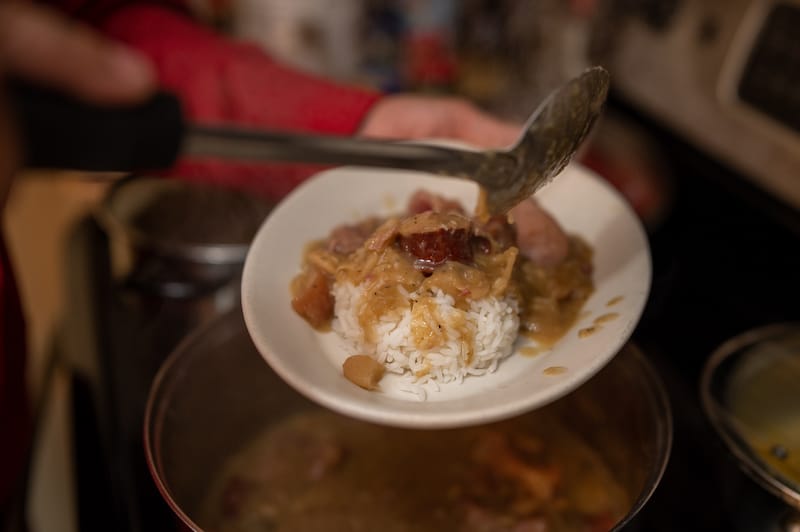
“I wanted to learn how to cook, but I also wanted to talk to her; she was so intelligent and knowledgeable,” said Young. “As we would talk about life while she taught me about cooking.”
But, most importantly, she taught Young to understand and honor her heritage.
“She would tell me things like, ‘We’re doing this because – for instance [in] red beans or a gravy – we put thyme in everything that we cook.’ Fresh thyme. And she reiterated, ‘Not that the shit in the jar, fresh thyme, and I’m like, ‘Why?’ and she would say ‘Just do it because we’re Creole.’”
Young’s Creole heritage informs everything she does both in and out of the kitchen. While at its most basic Creole simply means a person who was born in Louisiana, in New Orleans, Creole has a more specific and nuanced meaning, especially in the 7th ward of New Orleans, which is known for its barrooms and skilled Creole cooks.
“Louisiana Creole is someone that is probably a mix of African American, Caribbean or African American and French and Spanish ancestry, and probably Native American as well. You’re a gumbo,” said Young.

It’s that mix of peoples and cultures that has created a unique and blended foodway that exists nowhere else.
“Creole cooking is an infusion of Caribbean food, African food, Spanish cuisine and French cuisine,” said Young. “Because you can find a little bit of each in our technique in Creole cooking. For instance, okra is African, béchamel is French, and jambalaya is based on paella, which is a Spanish dish. It’s all mixed together to make one great cuisine. That’s the good thing about Creole food. There’s probably something you can find that you [will enjoy] because it’s so broad.”
And while Young hews closely to tradition, she is not bound by it. Her overstuffed seafood potato, known as “The Pontchartrain” in homage to the lake that forms New Orleans’s northern boundary, is a decadent delight that features a baked potato stuffed with a whole fried catfish and topped with a cheesy, creamy seafood sauce of shrimp, crawfish and crabmeat. It is enough to feed one New Orleanian, or three normal people. And her burger, “The Crawbaby,” two seared beef patties topped with a homemade crawfish sauce, shows a playful use of Louisiana’s favorite crustacean.
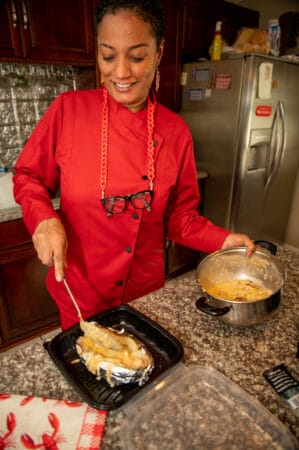
But by and large, her menu showcases the Creole soul food that she grew up cooking and eating in the 7th Ward. And many of the offerings pay homage to the women who taught her: Stuffed bell pepper with baked chicken – Queen’s recipe; Crawfish Etouffée and Catfish – Roena’s Recipe; Red Beans and Rice – Gladys’s Recipe. These stand alongside smothered turkey necks, spaghetti and meatballs, and mustard greens, dishes that mark occasions and days of the week in New Orleans. Food that is grounded in the culture of the city.
“What I wanted to offer was a taste of New Orleans,” said Young. “If you look at my menu, and you want to try étouffée for the first time, it’s there. The gumbo, it’s there. Red beans, a little taste. And then different things I’ve added, like pasta dishes that a lot of people may not be familiar with. We do a jambalaya pasta here.”
Not a bad repertoire for someone who had spent her previous 25 years working as an accountant before taking a leap of faith.
“The job wasn’t working out for me,” said Young. “And I was already going to do part time catering. And it just happened – literally, just happened. And this has been happening ever since. And it’s great. It’s doing great.”
But Young’s overarching mission is to perpetuate, preserve and educate people on Creole culture and the identity of the city she loves.
“New Orleans is unique unto itself,” said Young, choosing her words carefully. “It’s a very special place. That’s not debatable. But because times are changing, I think about down the line and how things were passed down to me and shared. So I do my best to be a cultural ambassador. To share it with my family, my nieces and my daughters, like it was shown to me. And I want to share it with the world. I want to stay authentic and keep New Orleans New Orleans.”
Young’s Crawbabies LLC food can be ordered via Doordash Weds-Sat, 12pm-8pm, as well as picked up. Call or text 504-217-7932 to order.
James CullenJames Cullen
Published on May 01, 2023
Related stories
December 8, 2021
TbilisiTbilisi stores and markets are festooned now with distinctive sausage-shaped candies called churchkhela, ready for New Year celebrations and then Orthodox Christmas on January 7. They are a very traditional Georgian specialty, usually homemade from grape juice thickened with flour and nuts. But those aren’t the only ingredients you need to make churchkhela – they…
July 13, 2015
TokyoSeveral years ago, when the Michelin Guide decided to swoop into Japan and rate its cuisine, restaurateurs were slightly shell-shocked to learn that Japan came away with almost as many highly regarded establishments as France. (And in fact, Tokyo wound up with two more three-star restaurants than Paris.) Then, in 2013, UNESCO put washoku (Japanese…
February 7, 2014
BarcelonaMorro Fi and Mitja Vida are two relatively new entrants to Barcelona’s vermuteo (“vermouthing”) culture, whose history stretches back to the turn of the last century. These two bars are the product of nostalgia for a bygone era fused with the social network- and urban design-driven present. The vermouth tradition in Barcelona was started in…







































